Research - (2021) Volume 11, Issue 3
Morpho-biological traits of sexed and non-sexed sperm of Holstein bulls
I. Goncharenko*, A. Getya, N. Svyrydenko and Y. PelichAbstract
Presented results of the comparative analysis of non-sexed and sexed sperm of the same Holstein bulls after defrosting considering: the concentration of spermatozoa in 1 ml, their motility, survival, the dynamic characteristics of the movement, the acrosome integrity (intactness), the level of microbial contamination. It has been established that the motility and survival of sexed sperm were lower by 15–20% compared with similar traits of non-sexed sperm. The sperm of the bull Vioris Sleeman HOCANM7817774 had the highest activity rate in non-sexed and sexed forms. This demonstrates the possibility of breeding bulls based on this quality trait. The experimental results indicate the necessity to improve the technology of freezing and thawing sexed bull sperm and the relevance of training specialists of breeding centers and farms in Ukraine.
Keywords
Holstein bulls, sexed and traditional semen, spermatozoa motility and survival.
Introduction
The Holstein cattle breed is one of the best-specialized dairy breeds. Holsteins are world leaders in terms of the number of life-long milk yield (100 thousand kg of milk and more), high daily milk yield (100 kg of milk and more), the amount of milk fat and protein for a single lactation and for the period of economic use. Long-term (more than 100 years) unilateral selection in milk yield ensured the formation of the classic exterior type of dairy cows. (Goncharenko, 2002).
Surprisingly, this specialized dairy breed is quite suitable for the production of medium-quality beef due to the size of the animals (live weight of full-aged cows 650–700 kg, bulls – 1000–1100 kg) (Goncharenko, 2002).
However, long-term unilateral selection in levels of milk yield negatively affected several essential indicators of milk quality and especially on the reproductive capacity of the broodstock (67–72% in farms with intensive industrial technology) and a short period of economic use of animals (2–2.5 lactation). The average content of fat and protein in milk (3.4 and 2.8%, respectively) is not enough to ensure the mass production of butter and cheeses. The fertility of females of this breed does not provide for expanded herd reproduction due to their offspring (on average, 70 calves per 100 cows, which is not enough with an annual herd turnover of 30–35%) (Albarrán-Portillo & Pollott, 2012).
It would seem that in such a situation, the use of sexed bull sperm is an ideal solution to many adverse accumulated problems in the breeding of Holstein dairy cattle, especially since the published works have confirmed the expected results of new biotechnology (the fertilizing capacity of sperm at the level of 50–70% of the first insemination and obtaining heifers at 92% of the offspring population). It is strange that biologists and breeders do not recommend the use of sexed sperm to the maximum extent at the first stages but emphasize the expediency and necessity of a comprehensive assessment of the offspring by the reproductive capacity of the broodstock and bulls, the sex ratio (bulls: heifers) in the offspring of cows and heifers in the breeding 'in themselves' of broodstock in F1, F2, F3, obtained using sexed sperm. (Hutchinson et al., 2013; Butler et al., 2014; Murphy et al., 2016; Maicas et al., 2019).
In this aspect, it is necessary to evaluate not only the results of the use of sexed sperm in breeding and commercial herds (taking into account the interaction 'genotype x environment'), but also the theoretical premises formulated by geneticists from different countries of the world (Butler et al., 2014; Maicas et al., 2019).
The stated prerequisites make it possible to decide on the advisability of studying the zoometric parameters of sexed bull sperm following the requirements of scientific research. Therefore, we researched semen from the same Holstein bulls - natural and sexed-supplied in sequins and offered for use in Ukrainian farms.
Materials and Methods
The technological equipment assessed the motility and morphological characteristics of spermatozoa in the cryopreservation laboratory of the LNPC LLC 'Zakhidplemresursi' in the Lviv region of the German company 'Minitub' according to the software package CASA (Computer Assisted Semen Analysis)–Sperm Vision. Defrosted bull semen was examined in 7 fields, with an average of 100 cells per field of view. The computer program provides graphic support of the analysis results with a color image of the trajectories of sperm movement.
The analysis was performed on individual samples, in the field of view, and on individual sperm. The total duration of the analysis was 15–20 seconds. The research was carried out on unsexed and sexed sperm of bulls-producers of the Holstein breed of Canadian selection from LLC 'Simex Alliance Ukraine'.
A study of the semen of 4 breeding bulls of different lines was carried out and investigated 24 sperm doses, of which 12 sperm doses of sex and 12 sperm doses of non-sexed sperm (Table 1).
| Name Individual. No bull | Line | Number of sperm doses | |
|---|---|---|---|
| Sexed sperm | Traditional sperm | ||
| Benjamin Red CANM 7866444 | Bell | 3 | 3 |
| Ardent HOUSAM 137922325 | Chif | 3 | 3 |
| Mathys CANM 103439288 | Chif | 3 | 3 |
| Vioris Sleeman HOCANM7817774 | Valiant | 3 | 3 |
Table 1. Researches of bulls producers sperm.
The sexed bovine semen was subjected to a separation process using high-speed flow cytometry to obtain fractions containing 87–92% of the Y-chromosome sperm. After separation, the semen was cryopreserved in 0.25 ml straws (Goncharenko&Fychak, 2014)
Sperm quality was assessed according to the following indicators: the concentration of sperm in 1 ml, their motility after defrosting, the number of sperm with progressively motile, non-progressively motile and non-motile, as well as after incubation at 37 °C after 60, 120, 180 minutes; intact acrosome, the level of microbial contamination (Dunin, 2011). Additionally, the dynamic characteristics of sperm movement were studied. The level of microbial contamination was determined immediately after thawing using standard microbiological methods. The results were statistically processed using Microsoft Excel software.
Results and Discussion
The results of studies of spermatozoa's morphological and biological properties isolated from sexed and traditional (non-sexed) sperm, taking into account mobility, survival, activity, and other generally accepted indicators in zootechnical practice, are shown in Table 2, 3. The digital material gives reason to state the following identified observations. Microbiological analysis of defrosted sexed sperm samples confirmed their sterility in all samples.
| Bulls | ||||
|---|---|---|---|---|
| Index | BenjaminCANM7866444 | Ardent HOUSAM 137922325 | Mathys CANM 103439288 | Vioris Sleeman HOCANM 7817774 |
| Concentration (billion. in 1 ml) | 0.04 ± 0.00 | 0.03 ± 0.00 | 0.05 ± 0.00 | 0.04 ± 0.00 |
| Activity, (%): after defrosting, |
49.33 ± 4.71 | 60.00 ± 5.52 | 58.00 ± 12.33 | 74.00 ± 1.22 |
| 3 hours after defrosting | 37.67 ± 2.48 | 34.00 ± 3.08 | 30.33 ± 5.89 | 42.33 ± 2.48 |
| Sperm with intact acrosome, (%): after defrosting |
88.33 ± 2.04 | 85.00 ± 3.54 | 88.33 ± 2.04 | 88.33 ± 2.04 |
| 3 hours after defrosting | 81.33 ± 1.63 | 76.67 ± 5.40 | 80.67 ± 0.82 | 76.67 ± 2.04 |
| Microbial contamination, (biol. obj. in 1 ml) | Sterile | Sterile | Sterile | Sterile |
Table 2. Biological indicators of thawed sexed sperm of sire bulls.
| Вulls | ||||
|---|---|---|---|---|
| Index | Benjamin CANM 7866444 | Ardent HOUSAM 137922325 | Mathys CANM 103439288 | Vioris Sleeman HOCANM 7817774 |
| Concentration (billion. in 1 ml) | 0.04 ± 0.00 | 0.03 ± 0.00 | 0.05 ± 0.00 | 0.04 ± 0.00 |
| Activity, (%): after defrosting, | 49.33 ± 4.71 | 60.00 ± 5.52 | 58.00 ± 12.33 | 74.00 ± 1.22 |
| 3 hours after defrosting | 37.67 ± 2.48 | 34.00 ± 3.08 | 30.33 ± 5.89 | 42.33 ± 2.48 |
| Sperm with intact acrosome, (%): after defrosting | 88.33 ± 2.04 | 85.00 ± 3.54 | 88.33 ± 2.04 | 80.67 ± 0.82 |
| 3 hours after defrosting | 81.33 ± 1.63 | 76,67 ± 5.40 | 80.67 ± 0.82 | 76.67 ± 2.04 |
| Microbial contamination, (biol. obj. in 1 ml) | Sterile | Sterile | Sterile | Sterile |
Table 3. Analysis of motility and survival of sexed sperm.
Comparison of the integrity of the acrosomes in cryodeconserved spermatozoa with sexed and traditional pies showed that the process of sperm separation did not significantly negatively affect this indicator. Incubation of sperm for three hours led to a slight decrease in germ cells with intact acrosome (Table 2, 3).
The mobility and survival rate of sexed spermatozoa compared to similar indicators of traditional sperm of the same breeding bulls is 15–20% lower, which should be considered in further improving the used technology. Similar results were obtained in the study of sperm motility, which was significantly lower in samples of sexed sperm.
Comparative characteristics of spermatozoa's rectilinear-translational movement in individual bulls indicate that in traditional sperm, they are much more mobile than in sexual sperm. This is especially noticeable 180 minutes after thawing, where spermatozoa with the rectilinear-translational movement of bulls Benjamin CANM7866444, Ardent HOUSAM137922325, Mathys CANM103439288 of traditional sperm were 2–2.5 times higher than those of the same bulls with sexed semen.
The highest activity was exhibited by the sperm of the bull Vioris Sleeman HOCANM7817774. It should be emphasized that this manufacturer's indicators of sperm activity in sexed and unsexed semen were relatively high (74% and 78%, respectively–Fig. 1). This indicates the possibility of selecting bulls for this indicator of semen quality. Therefore, a comprehensive assessment of breeding bulls should be supplemented with their sperm production and fertility (Lebedev, 2000; Pyzhova, 2011).
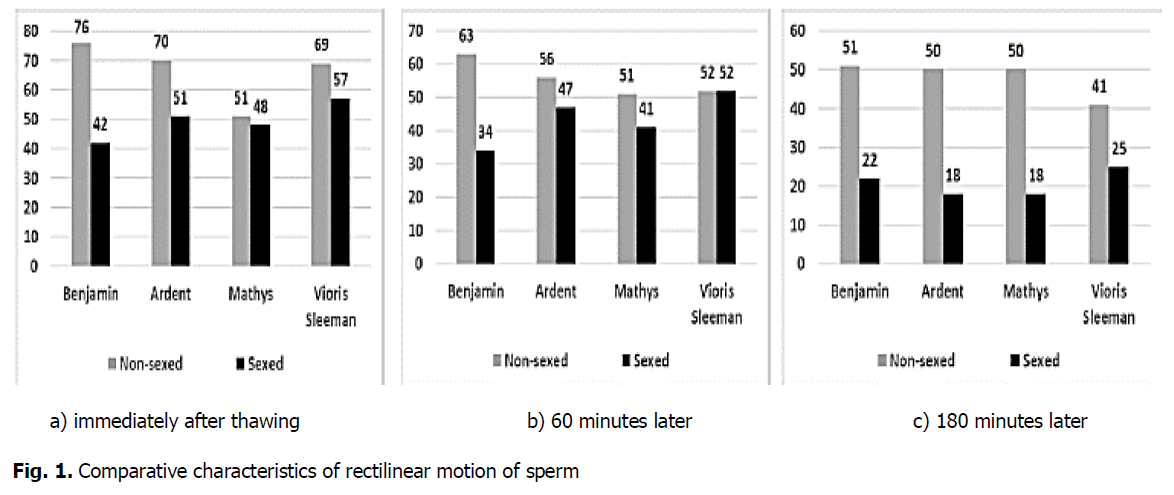
Fig 1: Comparative characteristics of rectilinear motion of sperm
Sperm quality scores in sexed sperm samples have, on average, minor variation with high negative scores (Fig. 2, 3).
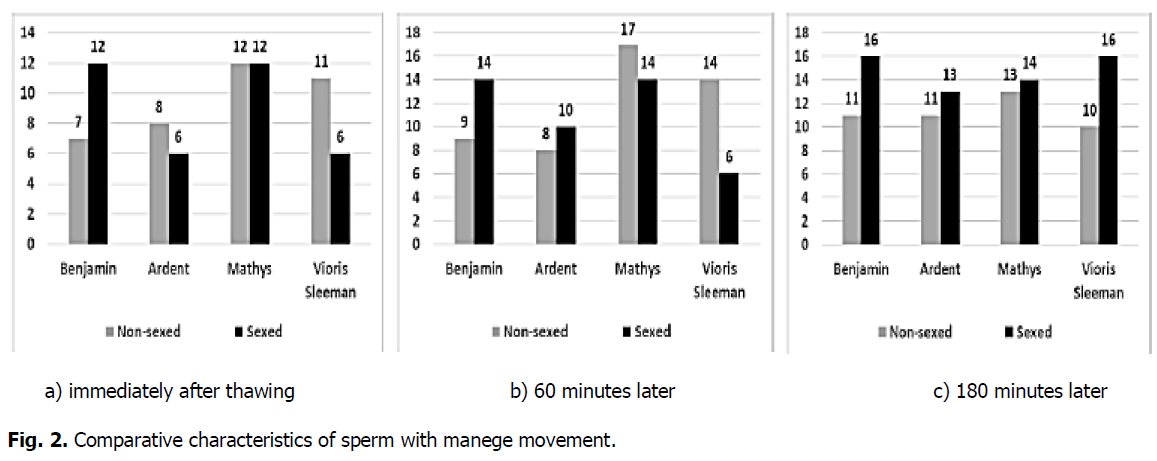
Fig 2: Сomparative characteristics of sperm with manege movement.
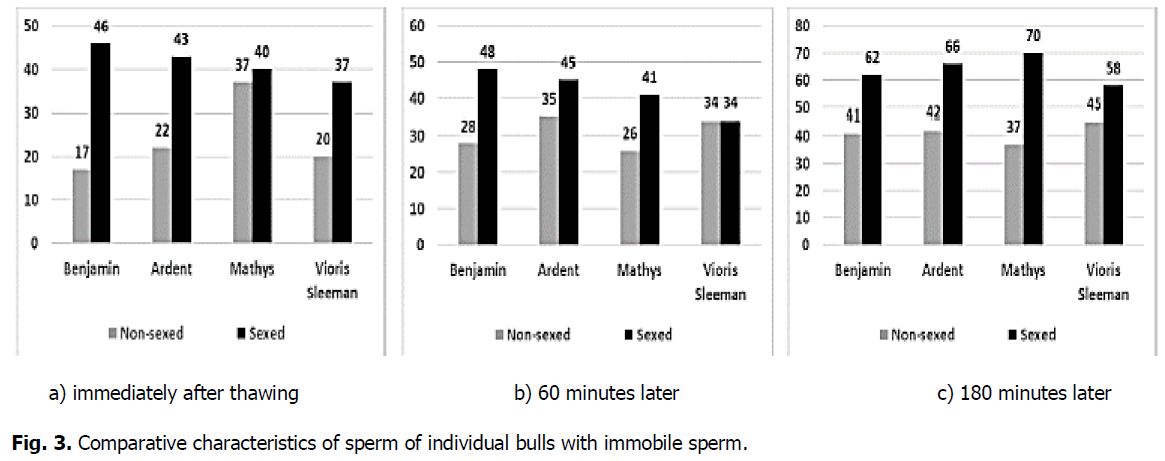
Fig 3: Сomparative characteristics of sperm of individual bulls with immobile sperm.
A similar situation is observed in Fig. 4, 5 regarding the survival rate of cryopreserved sperm. In all studied bulls, the survival rate of cryopreserved spermatozoa is worse in sexed sperm samples.
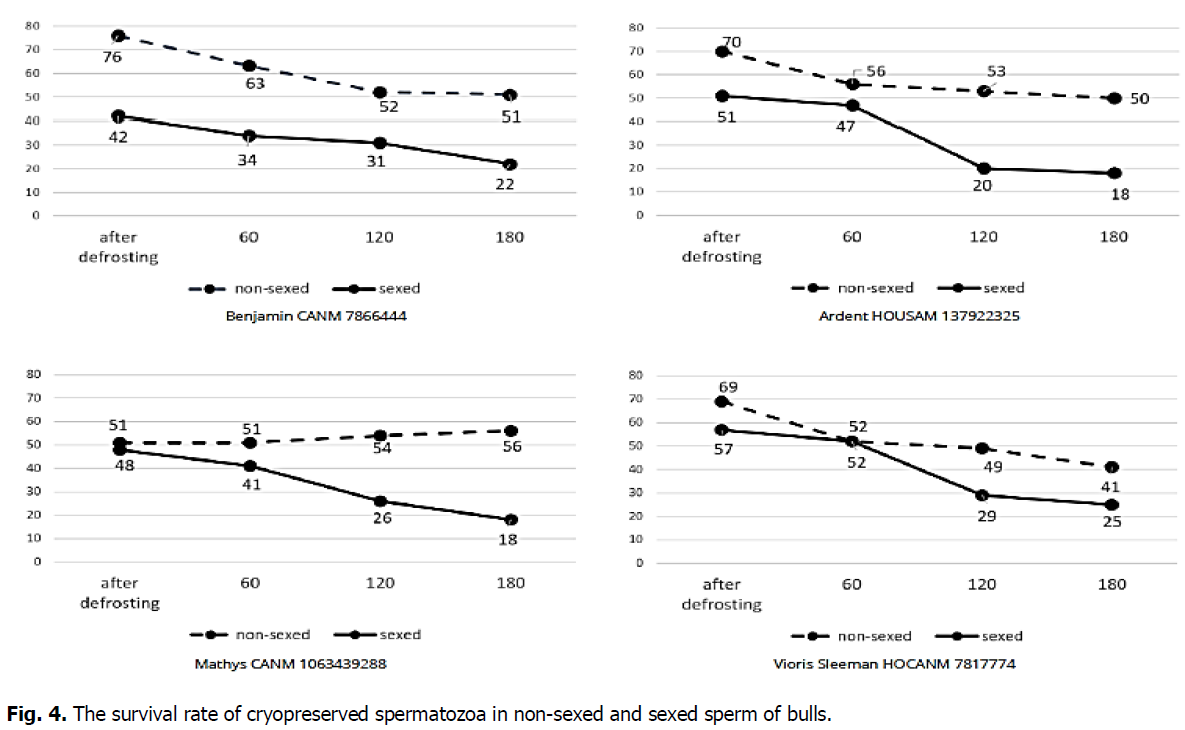
Fig 4: The survival rate of cryopreserved spermatozoa in non-sexed and sexed sperm of bulls.
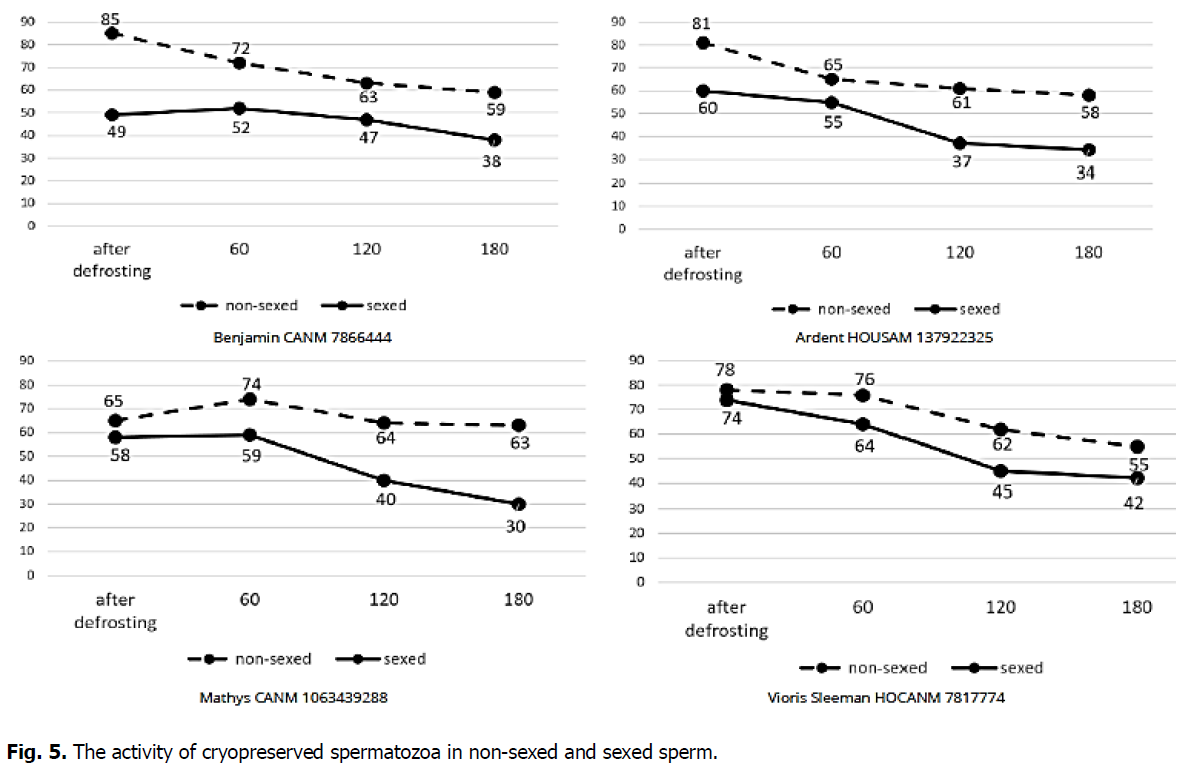
Fig 5: The activity of cryopreserved spermatozoa in non-sexed and sexed sperm.
One should not be too pessimistic about the experimental results obtained. Similar problems arose at the initial stages of developing and mastering the technology of freezing and thawing of native bull sperm. It is known that these problems have been successfully solved.
Therefore, it is necessary to systematically study the genotype of some generations of offspring obtained with sexed sperm, including analyzing the balance of chromosomes in tissues and the body as a whole. The development and practical application of sexual sperm from bulls-producers is the most considerable achievement of biological science in the breeding and reproducing of farm animals in the XXI century. It will also affect the methods of preserving the gene pools of living organisms, the pace of their evolution, and the intensity of the breeding process, especially with the creation and functioning of paternal and maternal lines, the use of the matroclinous effect, and other aspects.
The technology for separating spermatozoa carrying the X or Y chromosome should be improved considering the experience and results of the development of traditional artificial insemination of farm animals. In connection with the introduction of sexed semen into world practice, assessing the quality of sperm from producers becomes especially relevant. Separation of semen by sex is a very aggressive procedure, and therefore it is necessary to use semen with high quantitative and qualitative indicators.
In subsequent experiments, it is necessary to study the efficiency of insemination of heifers with sexed sperm taking into account the following indicators: fertility (%), the sex ratio in the offspring (%), characteristics by a set of indicators of first-calf cows obtained using sexed sperm in comparison with their mothers.
Conclusion
1. In the studied samples of thawed sexed sperm, the sperm concentration was 33–49 million in 1 ml, and their activity (mobility) immediately after thawing was within 49–74%, while this figure is traditional (not divided by sex) sperm was higher at 15–33%.
2. The mobility and survival of divided by sex sperm compared with similar indicators of traditional sperm of the same breeding bulls are 15–20% lower, which should be considered in further improving the technology used.
3. The highest sperm activity was possessed by bull Vioris Sleeman HOCANM7817774 (78 and 74% respectively), which indicates the possibility of selecting bulls for this indicator of sperm quality. Therefore, a comprehensive assessment of breeding bulls should be supplemented by their sperm production and fertility indicators.
References
Albarrán-Portillo, B., Pollott, G.E. (2013). The relationship between fertility and lactation characteristics in Holstein cows on United Kingdom commercial dairy farms. Journal of Dairy Science, 96:635-646.
Butler, S.T., Hutchinson, I.A., Cromie, A.R., Shalloo, L. (2014). Applications and cost benefits of sexed semen in pasture-based dairy production systems. Animal, 8:165-172.
Chernyak, N.G., Honcharuk, O.P. (2012). Usage of sexed sperm bugs in dairy cattle. In: Breeding and genetics of animals 46:223- 226.
Dunin, I., Erokhin, A., Dunin, M., Kochetkov, A. (2011). The efficiency of insemination of heifers with sexed semen. Dairy and Beef Cattle Breeding, 3:9-10.
Goncharenko, I.V., Fychak, V.M. (2014). The main elements of technology for the use of sexed bull semen in cattle breeding. Exclusive Technologies, 3:42-45.
Goncharenko, I.V. (2002).The degree of correlation between the reproductive functions of cows and their milk productivity. Bulletin of Sumy NAU. Livestock Series 6:287–291.
Hutchinson, I.A, Shalloo, L., Butler, S.T. (2013). Expanding the dairy herd in pasture-based systems: The role of sexed semen use in virgin heifers and lactating cows. Journal of Dairy Science, 96:6742–6767.
Lebedev, N.A. (2000). Resistance to freezing and fertilizing ability of bull sperm, depending on its receipt and dilution conditions. Belarusian State Agricultural Academy, Gorki, Belorussia, p:20.
Maicas, C., Hutchinson, I.A., Kenneally, J., Grant, J., Cromie, A.R, Lonergan, P., Butler, S.T. (2019). Fertility of fresh and frozen sex- sorted semen in dairy cows and heifers in seasonal-calving pasture-based herds. Journal of Dairy Science, 102:10530–10542.
Murphy, C., Shalloo, L., Hutchinson, I.A., Butler, S.T. (2016). Expanding the dairy herd in pasture-based systems: The role of sexed semen within alternative breeding strategies. Journal of Dairy Science, 99:6680–6692.
Pelikh, Y.S. (2012). Selective assessment of the first-rate corians, taken for the victorious sex sperm. Scientific Messenger of Lviv National University of Veterinary Medicine and Biotechnologies, 14:144–148.
Pyzhova, E.A. (2011). Evaluation of the reproductive ability of sires by a complex of traits, PhD Thesis, Russian scientific breeding research institute, Bykovo village, Russian Federation, p:21.
Turchanov, S. (2007). The biological value of thawed semen. Livestock in Russia, 8:45.
Author Info
I. Goncharenko*, A. Getya, N. Svyrydenko and Y. PelichCitation: Goncharenko, I., Getya, A., Svyrydenko, N., Pelich, Y. (2021). Morpho-biological traits of sexed and non-sexed sperm of Holstein bulls. Ukrainian Journal of Ecology, 11 (3), 322-327.
Received: 01-Jun-2021 Accepted: 03-Jul-2021 Published: 24-Aug-2021, DOI: 10.15421/2021_179
Copyright: This is an open access article distributed under the terms of the Creative Commons Attribution License, which permits unrestricted use, distribution, and reproduction in any medium, provided the original work is properly cited.
